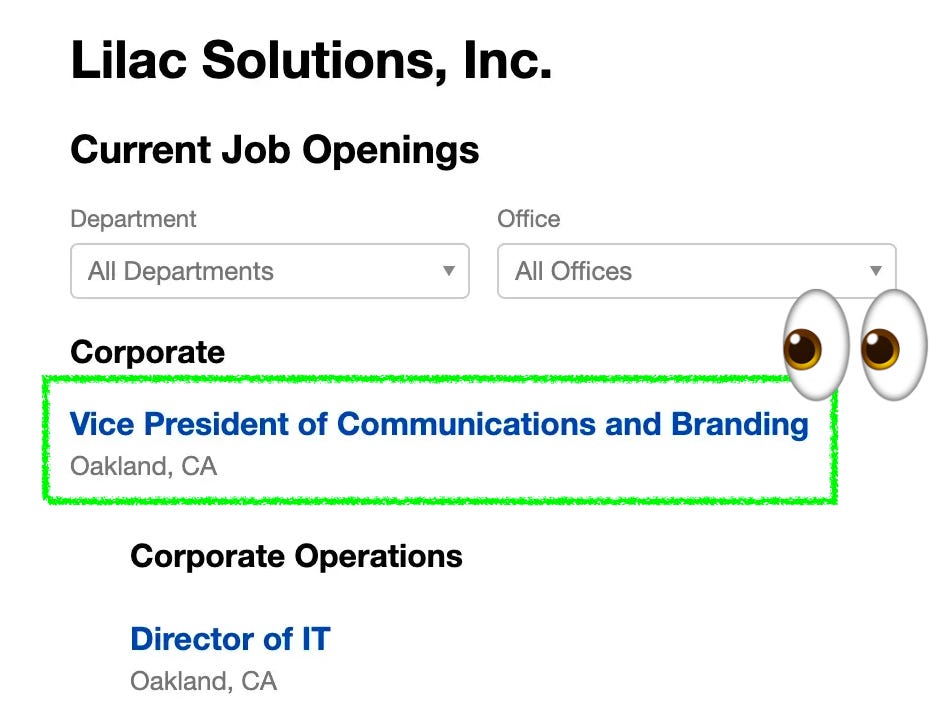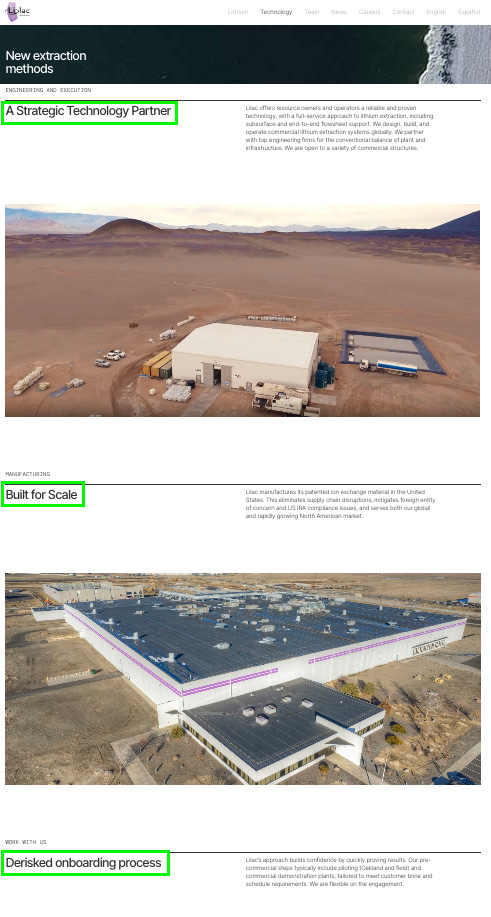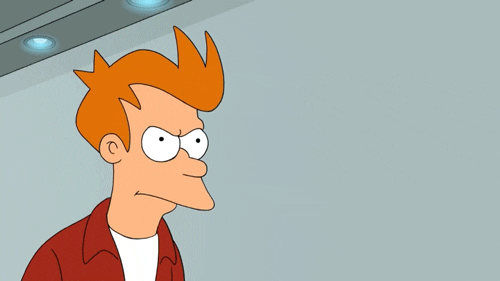Brand Audit in Climate Tech: Lilac Solutions
A Step-by-Step Workflow from Problem Statement to Brand Narrative Update
👋 Hello there to 2,365 climate buddies 🌳
Climate is not a technology problem but a story problem.
Delphi Zero is a consultancy and newsletter about the narrative potential of climate.
📧 If you are opening this essay in your email inbox, I recommend to click on the title of this piece to enjoy the full-length version in the browser.
Climate Tech companies are building the future. But sometimes communication challenges are in the way of turning their technology magic into a commercial reality.
This series tackles this question
My goals with this essay are:
📘 Provide a framework of how to solve real-life comms challenges
🧙 Show how to pull these small solutions into a coherent mythology
✍️ Teach you how to do it on your own
We will do this by looking at Lilac Solutions - a well-funded climate tech company 🟣
Brand Audit in Climate Tech: Lilac Solutions
By Art Lapinsch (illustrations generated via Midjourney)
Spotlight on Lilac Solutions
So why did I pick Lilac Solutions (referred to as ‘Lilac’ going forward)?
Back in February, I was curious if any of the larger climate tech companies were hiring comms specialists and found an open position at Lilac - VP of Communications and Branding 👀
Looking at the Job Description
The job description gives us a direct insight into the needs of the company👇
The Vice President of Communications and Branding will report directly to the Chief Executive Officer and will work closely with the executive team to develop the company’s global brand and oversee all internal and external communications and public stakeholder engagement.
This individual will lead all aspects of communication and branding, including strategy, PR, programming, events, and engagement as well as select, qualify, and work with third party agencies to achieve these goals.
As such, we are seeking a highly effective and thoughtful storyteller who can appropriately position Lilac, its mission, and its value proposition in a nuanced and elevated way to a variety of external constituencies including site partners, government agencies, clean energy advocacy groups and NGOs, local communities, investors, the Board of Directors, etc.
Ultimately, this individual’s mandate is to develop and execute a comprehensive communications and branding strategy to raise Lilac’s profile as the world’s foremost lithium extraction technology company.
tl;dr: “Position Lilac as the best-in-class lithium extraction technology company” by
🟣 Developing a brand for internal & external use
🔪 Sharpening the value proposition for various audiences
This job description will guide our brand audit of Lilac.
What Does Lilac Do?
First, we need to understand what Lilac is.
About Lilac Solutions, Inc.
Lilac Solutions is a lithium extraction technology company focused on scaling lithium production for the electric vehicle era.
Lilac solves the critical technology problems which today prevent development of the world’s largest lithium resources: low yields, high costs, slow start-up, poor reliability, and massive environmental impacts. Lilac’s technology represents such a step-change in performance and cost that it also unlocks the development of new unconventional lithium deposits with low lithium grades and high impurities, which have historically been impossible to produce.
In 2021, Lilac raised $150M in Series B financing from investors including T. Rowe Price, Lowercarbon Capital, Breakthrough Energy Ventures, Sumitomo, BMW and SK Materials. Lilac is committed to building a diverse and inclusive workplace.
tl;dr: Lilac extracts lithium faster, cheaper, and safer.
Now, that we have a job description and some basic context, we can start auditing the brand.
Lilac Solutions: Brand Audit
Remember, a brand audit establishes a baseline hypothesis.
Collecting Information in the Brand/Narrative Pyramid
As mentioned in my previous essay, we start by sifting through public information:
→ Website: The most helpful sites are the main landing page, the /about, the /solutions, and the /careers pages. You can deduce a lot from there (e.g. Vision; Mission; Brand Promise/tagline; Value Proposition; RTBs/Proof Points).
→ LinkedIn: Great to find a standardized boilerplate section on the company.
→ Press Releases and Blog Posts: You can derive brand focus areas via looking for repeating narratives/language/words.
The initial brand audit resulted in this 👇
How to read this audit:
⚫️ Bold - Cornerstone Keywords
🟣 Purple - Statements that felt important to me
🔴 Red - Possible areas of tension in the narrative
❓ Question Marks - Missing insights, since I couldn’t access this information
Here is my quick-and-dirty analysis on Lilac:
💪 Strengths
High-level Talking Points Are Aligned: Vision, mission, and brand promise “click” fairly well.
Strong Technology Focus: A lot of the language revolves around DLE (Direct Lithium Extraction) technology. This is well-aligned with the company’s intent to become a thought leader for this technology.
Good stuff to work with.
🧐 Opportunities
Brand Attributes/Values: I’m not 100% clear what the brand stands for. (see explanation in the “Values: Reference for Brand Decisions” section and solution in the workflow section below)
Narrative Focus: Currently, the narrative jumps around between (1) a broad focus on the energy transition and (2) a narrow focus on the electric vehicles industry. This creates confusion on various levels of the Narrative Pyramid. (see explanation in the “Verticality: Consistency Across all Levels” section and solution in in the workflow section below)
Re-Structure the Value Proposition: Good content but not clear enough. (see explanation in the “Horizontality: M.E.C.E. on the Same Level“ section and solution in the workflow section below)
Room for improvement with a couple of quick fixes 👇
Lilac Solutions: The Workflow
Now, let’s work through the “job responsibilities” from the original job post 👇
“Compelling Brand Identity and Narrative”
The first responsibility from the Job Description was:
Creating a comprehensive communications strategy and a compelling brand identity and narrative to establish Lilac as a global leader in Direct Lithium Extraction (DLE).
This tells me that Lilac’s goal is to be perceived as an authority in the DLE space and needs a brand and narrative, which is aligned with that goal.
Let’s tackle the opportunities one-by-one.
💜 Value: Focus on Three Meaningful Core Values
Brand Attributes/Values: I’m not 100% clear what the brand stands for.
Reading through Lilac’s public communications, I left with two distinct impressions:
A strong focus on the technological aspects (tech specs; data points; etc.) as seen in the wording, imagery, and focus of their landing page.
A very human - almost tongue-in-cheek - tone of voice in their news updates from their founder Dave Snydacker when mixing corporate updates (i.e. “I transitioned out of the CEO role”) while incorporating funny trivia (“I didn’t fit the typical CEO archetype because I played drums in an Indie rock band”).
Both are great in their own way, but it leaves me wondering: Is this intentional? If yes, is there a better way of blending these two worlds?
I’d suggest distilling it down into three clear brand values that can be felt across each touch point - regardless whether it’s a landing page for risk-averse project developers or a news update for friendly investors. As explained in the previous piece:
That’s why, I start my client work by focusing on their brand values. Not some aspirational brand values - which have nothing to do with reality - but the actual cultural codes that make their company tick.
… we synthesize the output into three values.
We use clear language that is specific enough so that everyone understands what it actually means.
Also, I challenge the client to stick to three values - not two, not four, three. This number strikes the perfect balance between (a) easy to remember and (b) comprehensive enough to triangulate when facing brand decisions.
A possible combination (and this is me just brainstorming out of my a$$ since I don’t have Lilac’s context) could be:
⛳️ Leading (Gold/Lilac standard; advanced tech/research-focused; “a messenger from the DLE future”)
✅ Assured (Honest/candid; direct; clear; factual; data-driven)
🏭 Consistent (Reliable over time; trustworthy; dependable regardless of use case)
A leader is leading, assured, and consistent. And so should be the leader in Direct Lithium Extraction.
Lilac knows how the Direct Lithium Extraction future looks like and they are leading the way for you. Their data-driven and factual approach makes them assured in their DLE solutions. Lilac is also a consistent partner, regardless whether you are a project developer or a governmental agency looking for a domestic champion.
Li + L.A.C. = Lithium + Leading. Assured. Consistent. = Lilac 💜
🔺 Verticality: Stick to a Consistent Narrative Across all Levels
Narrative Focus: Currently, the narrative jumps around between (1) a broad focus on the energy transition and (2) a narrow focus on the electric vehicles industry. This creates confusion on various levels of the Narrative Pyramid.
I see a slight inconsistency in their communications:
Lilac’s vision is a future where 100% of all vehicles are electric. As a result, we need 10x the amount of today’s lithium.
Lilac’s boilerplate states that “Lilac’s mission is to scale global lithium production to support the electric vehicle industry and energy transition.”
So what is Lilac’s goal? 100% EVs or the energy transition? Both goals have very different strategic implications because one goal is specific while the other one is broad.
I would recommend having an honest conversation about the true corporate objectives and the reason why the specific language was chosen.
There are two possible solution pathways:
🚙 Narrow Focus - Automotive First: Maybe, Lilac has a singular focus on the automotive industry because they concluded that it is better to be a big fish in a smaller pond. It is easier to become the leader and capture a significant share in a niche. I know that Lilac has strategic investors from the automotive world like BMW iVentures. If this is the correct/desired route, then it makes sense to specify the communication across all the levels of the Narrative Pyramid and double down on automotive and the EV narrative.
🏭 Broad Focus - Industrial Decarbonization: Maybe, Lilac’s ambitions go beyond automotive and their goal is to become the technology leader in DLE with a broad set of applications and it just so happened that automotive was the first “vertical” to be catered to. In that case, it could be helpful to maintain the broader vision across the Narrative Pyramid while keeping “automotive” as a dedicated segment of their solution portfolio.
This is a highly strategic decision and would require insight from Lilac’s leadership. But, since this is my newsletter, I have the freedom to hypothesize the living Christ out of this decision.
My rationale goes as follows: I’m thinking that I’m a well-funded venture-scale climate tech company. My goal is to make a real dent in the decarbonization of our global economy. Lithium has many use cases and I can have the biggest impact by deploying the best lithium extraction technology (i.e. DLE) to all these verticals. That’s why I aim to become the authority in DLE for anyone who’s interested. I would focus on the broad message “scaling lithium supply for the electric era” and automotive happens to be my first beachhead market. I land in one vertical, then I conquer, and then I move on to the next vertical. Automotive → utility-scale battery production → etc.
Now the question is: Does this story align with my reference values?
Leading: Lilac is the DLE expert that brings 10x unlock to all Lithium Extraction verticals.
Assured: Lilac has proof-of-concept for the technology.
Consistent: The playbook from one vertical can be replicated to other verticals. Lithium is Lithium is Lithium. It’s the same commodity across verticals.
It checks the value boxes ✅
Now off to the next challenge.
🗂️ Horizontality: Use M.E.C.E. Framework for Value Proposition
Re-Structure the Value Proposition: Good content but not clear enough.
I like to tie Value Propositions back to their relevant customer Pain Points.
Since I don’t have that insight, I’ll base the analysis on the Value Propositions (i.e. A Strategic Technology Partner; Built for Scale; De-risked Onboarding Process) on Lilac’s Technology page.
Remember the M.E.C.E. methodology?
…the M.E.C.E. framework - it stands for Mutually Exclusive, Collectively Exhaustive.
The basic idea is that elements on the same communication level each occupy their own distinct area (i.e. mutually exclusive) and collectively bear the weight of that particular level of the structure (i.e. collectively exhaustive).
Keeping this in mind, we could re-package the Value Proposition bundles to be mutually exclusive and collectively exhaustive:
🦾 Superior Technology: Lilac’s patented DLE technology is X-times better than conventional extraction processes.
🔑 End-to-End Service: Lilac offers customized turn-key solutions - any scale, any industry.
🤝 Reliable Partnership: Lilac strengthens domestic supply chains and reduces upstream risks by being a US-based producer. Good for clients and good for the government.
Is it clear? Yep.
Is it aligned with the DLE Leadership goal? Yep.
Is it aligned with the values? Yep.
Lilac Solutions: Updated Brand Narrative
This leads us to this updated version of Lilac’s Narrative Pyramid 👇

The updated version should have maintained the existing strengths and improved the opportunity areas:
High-level Talking Points Are Aligned: Vision, mission, and brand promise “click” fairly well. ✅
Strong Technology Focus: A lot of the language revolves around DLE (Direct Lithium Extraction) technology. This is well-aligned with the company’s intent to become a thought leader for this technology. ✅
Brand Attributes/Values:
I’m not 100% clear what the brand stands for.(see explanation in the“Values: Reference for Brand Decisions”section and solution in the workflow section below)→ Three core values to triangulate brand decisions: (1) Leading, (2) Assured, and (3) Consistent ✅Narrative Focus:
Currently, the narrative jumps around between (1) a broad focus on the energy transition and (2) a narrow focus on the electric vehicles industry. This creates confusion on various levels of the Narrative Pyramid.(see explanation in the“Verticality: Consistency Across all Levels”section and solution in in the workflow section below)→ Focus on broad goal of lithium supply for the electric era with automotive being the first beachhead market ✅Re-Structure the Value Proposition:
Good content but not clear enough.(see explanation in the“Horizontality: M.E.C.E. on the Same Level“section and solution in the workflow section below)→ Clarify Value Propositions into three M.E.C.E. compliant buckets: (1) Superior Technology, (2) End-to-end Solutions, and (3) Reliable Partnership ✅
“Supporting Global Divisions and Departments”
Another responsibility in Lilac’s job description is:
Supporting multiple global divisions and departments including sales, lithium technology, materials manufacturing, and natural resources with any communication or branding needs.
Here’s my pragmatic take: Ideally, all departments talk about the same things but in their own language.
As an example, technical documentation for project developers needs more fidelity than a recruitment-related landing page. Just use common sense.
Keep it simple and use the elements of the Narrative Pyramid and adapt it to the requirements of the various teams.
Examples:
Technical Writer: Use the Narrative Pyramid structure as a guideline for creating internal/external assets. As long as it’s aligned with the main talking points of the narrative, you can go as much into detail as you want.
Sales: Use the Narrative Pyramid as a guideline for creating sales assets (pitch decks; landing pages; etc.) As long as it’s aligned, you’re good to send it out.
Recruiters/HR/Onboarding: Use the Narrative Pyramid as a sequence when talking candidates or newly hired employees through the big picture of the company.
You get the gist.
A beautiful benefit of using the Narrative Pyramid is that it significantly reduces the amount of iterations needed when creating content assets. Alignment happens through an evergreen reference vs. “hopping on a call.”
“Developing Top-Notch Communication Materials”
Additionally, the VP role is asked to:
Developing top-notch communication materials, including statements, press releases, executive messages, and website/social media content to reflect the company’s nuanced position on various complex matters.
The question is: “Who says what, when, how, where, and to whom?”
The way I would approach it is by dividing sections of the Narrative Pyramid and split them amongst the various functions of the team:
CEO (who) talks about the vision (what) at conferences, press events, etc. (when/where) to other executives, analysts, investors, etc. in big-picture terms (how).
CTO (who) talks about the mission and its technicalities (what) at conferences, internal events, etc. (when/where) to technical customers, investors, technical talent, etc. in high-level technical language (how).
Product Manager (who) talks about the product and its value props/proof-points/features (what) in technical/marketing/sales documentation (when/where) to customers, talent, etc. in specific language that the target customer would use (how).
Additionally, if you read the Narrative Pyramid top-to-bottom and left-to-right, it helps structuring your content roadmap (PR/Journos/bloggers/etc.; Internationalization/Global GTM; Internal/external events; etc.).
Content Sequence: First piece is about the vision, second piece is about the company’s purpose, and so on.
Content Multiplication: You can multiply the same content sequence by having different messengers (e.g. CEO; CTO; Product Manger; etc.) talk about the same talking points in (a) their respective language and (b) to their respective audiences.
The result is a consistent message across all levels, all messengers, and touch points over time.
This is how you build a winning brand.
Do You Need Help With Your Narrative?
Since I have you here, I wanted to tell you two things.
I consult climate tech companies on getting their brand narratives right.
If you or one of your portfolio companies needs help, ping me on LinkedIn and message me 👇
— End of the Commercial Break —
💜 Lilac’s Future Mythology 🧙
Let me ask you: What is the purpose of a technology business?
I’d argue that its purpose is to solve a market need (= customer pain point) in a profitable manner (= business objective) with technology (= means).
Your customer should be the hero of your mythology.
Andy Raksin’s “The Greatest Sales Deck I’ve Ever Seen” provides us with a 5-step version of this idea. Let’s apply this framework and build Lilac’s mythology:
⛈️ A Change in the World: Climate change is real and we have to decarbonize our global economy. One of the key levers is the electrification of various industries. Batteries are the backbone of electrification and we will need 10 times more Lithium than we use today.
🏅 Winners and Losers: Lithium supply is the main bottleneck. Whoever manages to extract Lithium will contribute significantly to the decarbonization of our economy while capturing a lot of value. But traditional means of extracting Lithium from brines is expensive, takes a long time, and has a negative environmental impact.
🏞️ The Promised Land: There’s a new approach called Direct Lithium Extraction (DLE), which is cheaper, faster, and better for the planet. Whoever switches to DLE will gain a competitive advantage.
🪄 The Magic Gift: Lucky for you, Lilac can design, build, and operate commercial DLE systems globally.
📑 Evidence: Lilac provides a patented Ion Exchange (IX) technology, offers you an end-to-end service from start to finish, and is a reliable partner from secure supply chains to regional policy compliance.
Want to develop a Direct Lithium Extraction project? It’s not too late to be early.
Future Mythology Cheat Sheet
At the beginning, I gave you a promise:
My goals with this essay are:
📘 Provide a framework of how to solve real-life comms challenges
🧙 Show how to pull these small solutions into a coherent mythology
✍️ Teach you how to do it on your own
In the first essay of this series, you built a foundation:
A brand is the (symbolic) meaning of something and branding is the (literal) representation of that essence.
A narrative - peppered with tension and release - helps the audience to remember the branded elements of a brand.
The purpose of marketing is to spread the brand far and wide.
Then, in the second essay, you learned that building a strong brand requires clarity and consistency over time. You can do this with a Narrative Pyramid.
These tactics help you to:
Use three values as a triangulation reference for all brand-related decisions.
Be mindful of the verticality principle to make sure that your message is consistent across all levels of the Narrative Pyramid
Use the horizontality principle to ensure that all elements are mutually exclusive and collectively exhaustive.
And in this essay, you learned how to take a climate tech brand from problem statement to brand/narrative update.
Congrats, my friend, you have learned the 80/20 of Branding for Tech Companies 🎉
🙏 Thanks, Matt for poking holes into my first draft. Thanks, Ben, Sara, Finn, Gniewko, and Anastasis for listening to early versions of this.
Get in touch via Linkedin if you want to chat about ideas, projects, or a potential collaboration✌️














This is killer content!